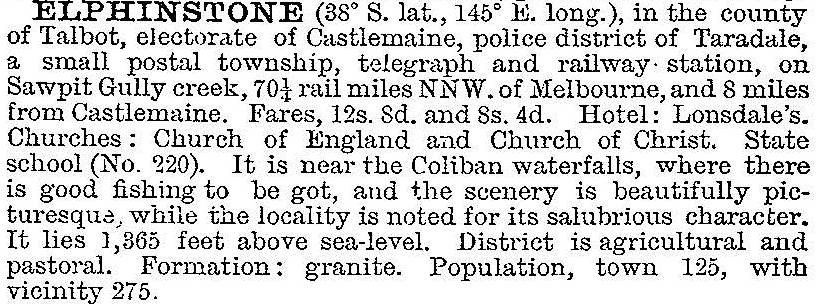Elphinstone
Elphinstone is a rural village on the Calder Highway and on the railway line from Melbourne to Bendigo. The railway line diverges from the Calder Highway at Elphinstone and follows the Pyrenees Highway to Castlemaine before rejoining the Calder Highway to Bendigo. Elphinstone has thus been a minor railhead for the carriage of agricultural produce brought from the west (Castlemaine) and from the east (Metcalfe and Sutton Grange). It is 12 km south-east of Castlemaine.
Elphinstone was named after Baron Montstuart Elphionstone, Governor of Bombay and Madras, India. It had been settled before the 1851 gold rushes and named Sawpoint Gully, as timber-getters had worked in the area. (The Fryers Range State Forest is south-west of Elphinstone.) Not much gold was found at Elphinstone, but while alcohol sales were banned at the diggings it was the nearest place for licensed premises, and after 1858 it was a wholesaling centre for liquor.
An Anglican church was opened in 1856, and was replaced by a government school in 1873. For some years school classes were held in the Anglican church (1861) built from bricks originally intended for the Elphinstone railway tunnel (1862). The tunnel was part of a massive regrading for the laying of rail track to Castlemaine and involved the excavation of a deep cutting. During the mid-1860s Elphinstone had four hotels, a railway station with a livestock yard, a flour mill and a population of about 300 persons. Later the railway goods-yard had timber sidings and a cool store. The Coliban main channel provided water for orchards. In 1903 Elphinstone was described in the Australian handbook:

Elphinstone is now bypassed in most respects: the Calder and Pyrenees Highways have an elevated interchange, and the railway station and freight yard are no longer used. Car travellers to Castlemaine mostly look down on the village, as they do with the railway cutting and tunnel on their way through the State forest. The church (1861), heritage-listed station (1863), hotel (1876), school (1869) and public hall are the village’s main buildings. In 2014 the school had 41 pupils. Elphinstone’s census populations have been:
| census date | population |
|---|---|
| 1861 | 187 |
| 1871 | 404 |
| 1891 | 125 |
| 1911 | 204 |
| 1933 | 146 |
| 1954 | 173 |
| 1966 | 151 |
| 2011 | 670 |
Further Reading
Karen Twigg and Wendy Jacobs, Shire of Metcalfe heritage study, 1994


